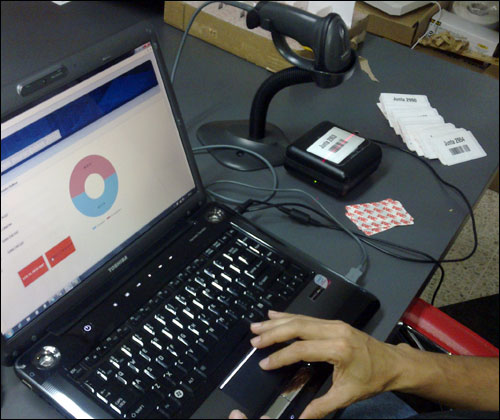Costa Ricans made history earlier this year, by electing their first female president, Laura Chinchilla. This coming December, there will be another first associated with that country’s elections. Radio frequency identification will be used to track and monitor the nylon sacks in which paper ballots filled out by voters are delivered from each of Costa Rica’s polling places to a central ballot-counting warehouse located in San Jose, the country’s capital. The goal is to boost the speed and accuracy of the ballot-collection process, explains Wilbert De La Hormoza, the CEO of Grupo Diverscan, the systems integrator that designed and will deploy the RFID system for Costa Rica’s upcoming district elections, which will take place on Dec. 5, 2010.
In past elections, the bags were checked in manually as they were brought into the central warehouse. But this process is tedious, De La Hormoza says, and can result in mistakes. It also takes a very long time, since the bags, once they begin arriving at the central warehouse—at around 6 pm on election day—often come in droves, causing the process of checking them in to get backed up. Using a battery-assisted passive (BAP) EPC Gen 2 RFID tag to identify each bag as it arrives at the warehouse, he adds, should greatly reduce the amount of time it takes election workers to process the bags. In addition, the same type of BAP tags will be attached to the identification badges issued to observers from the different political groups, who will be coming to the warehouse during election night. The intention is to collect data that shows which observers arrived at the warehouse, and when.

The RFID system has been tested, De La Hormoza says, and an RFID-tagged ballot bag has been issued to each of the 5,250 polling places that will participate in the Dec. 5 election (the larger, presidential elections consist of 7,000 polling places, but the next such election will not take place until 2014).
Grupo Diverscan selected PowerID to provide the RFID tags for the system, Motorola to supply readers, and Costa Rican software developer idGen to provide software to collect and filter the tag data. PowerID’s PowerG-U403 tag, tuned to operate in the 902 to 928 MHz range, will be attached, via a strong adhesive, to each ballot bag, as well as to the employee badges. The tag is compliant with the EPC Gen 2 standard, but its onboard battery allows for a longer read range than would be seen in a totally passive Gen 2 tag. The read range of the company’s line of PowerG tags, says Erez Kahani, PowerID’s CEO, is roughly 165 feet in open air.
Upon arriving at the central warehouse, the bags will be brought in on pushcarts through a reader portal formed around the main entrance, using a Motorola XR480 fixed-position reader and Motorola antennas, to create a read zone all around the entrance. The bags will then be moved down a long hallway and, before entering the ballot-counting area, carted through a second portal (also using the Motorola XR480 reader and antennas), in order to provide a second reading zone, in the event that any tags are not read by the first portal. Each time a tag is read, the idGen software will collect the unique ID encoded to that tag, as well as a time stamp, and forward this information to a main database, where each ID is associated with the polling station to which that tag was issued.
Throughout the evening, election officials may also utilize handheld Motorola MC9090 interrogators, to seek out specific ballot bags from key districts, before the bags are brought through the first portal. This will be done in order to pull these bags from the main stream of bags entering the facility, so that they can be immediately opened and counted. Doing so will provide important information to the election officials regarding the direction in which certain ballot items are trending.
According to De La Hormoza, a bar-coded label will be attached to each bag as well, printed with the same unique ID encoded to each tag, so that officials will have a back-up means for collecting the number (using a bar-code scanner) in the event that a tag ceases to function.
Because large numbers of bags often arrive at the central warehouse simultaneously, they will be stacked atop each other on the carts used to bring them into the facility. With a large number of bags thus piled, a fully passive tag could be difficult to read. To that end, Grupo Diverscan opted to use the PowerID BAP tags (also known as semi-active tags). The tag’s battery powers its chip, so it need not scavenge energy from the reader’s RF signal in order to power the ID’s transmission back to the interrogators. This makes the reading process less susceptible to interference from other tags, or from such environmental factors as metallic surfaces or moisture.
This will not be the first time that RFID is used for tracking ballot bags. In 2007, California’s Alameda County employed passive EPC Gen 2 RFID tags to track canvas bags, each containing a memory cartridge encoded with the voting results scanned from all paper ballots for that location; a PCMCIA card storing the voting results from touch-screen voting machines (used by disabled voters unable to utilize the paper ballots); and a paper list naming all individuals who voted at that site (see Alameda County Gives RFID Ballot-Tracking a Vote of Approval). What’s more, De La Hormoza says, election agencies in Colombia and Brazil have used RFID for tracking election documents in the past. But this bag-tracking application, he notes, will be the first major deployment of the technology in Costa Rica.

